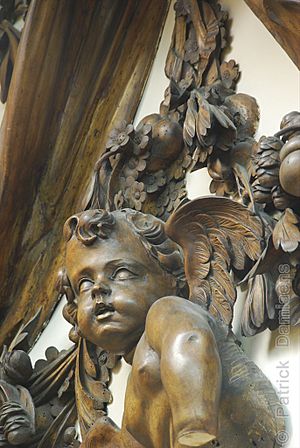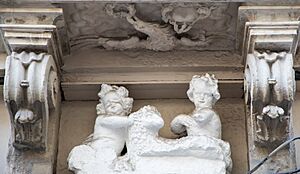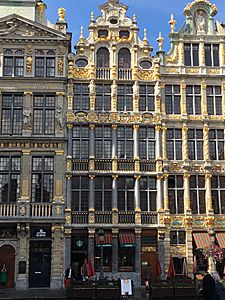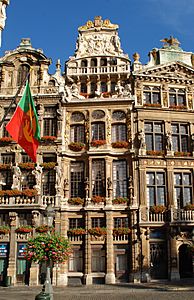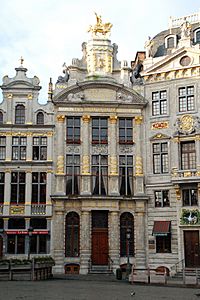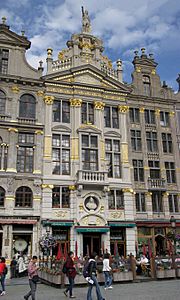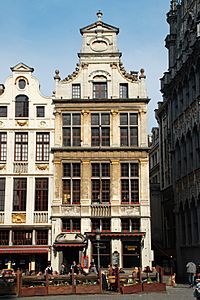Peter Van Dievoet facts for kids
Quick facts for kids
Peter van Dievoet
|
|
|---|---|
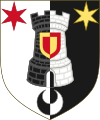
Personal arms
|
|
| Born | 1661 |
| Died | 2 March 1729 (68 years old) Brussels
|
| Nationality | (1661-1714) : Spanish Netherlands (1714-1729) : Austrian Netherlands |
| Known for | Sculpture, architecture |
|
Notable work
|
Statue of James II, Trafalgar Square and many of the Houses of the Grand Place, |
| Style | Baroque, classical |
| Spouse(s) | Dorothée de Witte |
| Elected | Guilds of Brussels, Drapery Court, Magistracy of Brussels. |
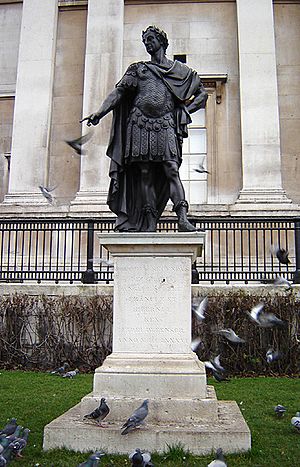
Peter van Dievoet (born in 1661, died in 1729) was a talented artist from Brussels. He was a sculptor, made statues, carved wood, and designed beautiful decorations for buildings.
He became well-known for his work on the guild houses in the Grand Place in Brussels. These buildings had to be rebuilt after a big attack in 1695. He also created the famous Statue of James II in Trafalgar Square, London.
Peter was the brother of Philippe van Dievoet, who was a goldsmith for King Louis XIV of France. He was also the uncle of Guillaume Vandive, a printer in Paris.
Contents
Peter's Life Story
Peter van Dievoet was born in Brussels and was baptized on June 29, 1661. His family, the Van Dievoet family, was well-known in Brussels. His father, Gilles van Dievoet, was a citizen of Brussels.
Peter's father passed away when Peter was about twelve or thirteen years old. His mother later remarried.
After living in Brussels for some time, Peter moved to England. There, he often visited the workshop of Grinling Gibbons, another famous sculptor. In 1686, Peter created and cast the statue of James II for a park in London. This statue is now in Trafalgar Square.
Peter returned to Brussels around 1688 because of a big political change in England called the Glorious Revolution.
In 1695, he became a master of the "Quatre-Couronnés." This was the guild for stonemasons and sculptors in Brussels. He was a highly respected sculptor. He played a big part in building the new Grand-Place in its beautiful Baroque style.
From 1713 to 1723, Peter was a judge for the Drapery Court of Brussels. This was an important group that managed trade in Brussels.
His Time in London
Many experts believe that Peter Van Dievoet's most important artworks are in England. They are considered some of the best of that time.
Peter worked in London for about eight years, from 1680 to 1688. He was part of the workshop of Grinling Gibbons, a sculptor who was a Quaker.
We don't know much about all the sculptures he made in England. Not much research has been done to find them all.
A historian named George Vertue wrote about Peter's work. He found a payment record for the bronze Statue of James II (made in 1686). He said Peter made it with another artist named Laurens from Mechelen. This statue was first in a place called Whitehall and is now in Trafalgar Square.
Another expert, Margaret Whinney, noticed that the statue looked more European than English. She also said that two artists from Flanders, Laurens of Mechelen and Dievot of Brussels, created it. Sir Lionel Henri Cust also agreed with this idea.
The "Laurens" mentioned is believed to be Laurence Vander Meulen, a sculptor from Mechelen.
His Time in Brussels
When Peter returned to Brussels around 1689, he had to join the local guild of stonemasons. He officially became a master in this guild, called the Quatre-Couronnés, in 1695. This is when his work in Brussels truly began. That same year, the city of Brussels was badly damaged by a French attack.
Even during his lifetime, Peter Van Dievoet was known as a very skilled sculptor.
Years after he passed away, a report from Brussels officials in 1771 listed Peter Van Dievoet among "very remarkable Brussels sculptors."
We know about some of his works in Brussels from old records. He is most famous for designing and creating many of the guild houses on the famous Grand Place.
Here are some of the works he created in Brussels:
Wood Carving
Peter van Dievoet was also very good at carving wood. For example, he made very detailed decorations of fruits and flowers from lime-wood. You can see these beautiful carvings at the Royal Museums of Art and History of Brussels.
He also carved special wooden emblems called "keerses." These were richly decorated and used for celebrations by the tailors' guild.
The House of the White Lamb
The House of the White Lamb was built in 1696. Peter Van Dievoet created the sculptures on its facade (the front of the building). This house is located on the Marché aux Herbes.
The Grand Place
Peter Van Dievoet sculpted the fronts of several guild halls on the famous Grand Place:
- La Maison du Sac (House of the Bag), number 4
- La Maison du Cornet (House of the Horn), number 6
- La Maison de l'Arbre d'Or (House of the Golden Tree), also known as the House of Brewers, number 10
- La Maison de la Chaloupe d'Or (House of the Golden Boat), numbers 24-25
He also worked as an architect for Le Heaume (The Helmet), number 34.
Public Roles
Peter also took on important public roles. From 1713 to 1723, when he was in his 50s and early 60s, he served as a judge for the Drapery Court of Brussels. This was an old Brussels organization similar to a chamber of commerce. Its members were called "brothers of the Guild."
After this, from 1723 to 1724, he became a Councilor for the City of Brussels. This meant he was a member of the city's government. After this, he stopped working in public life.
Peter was a religious man. Until the end of his life, he was a marguillier (a churchwarden) at the Sainte-Gudula collegiate, which is now a cathedral. He passed away in Brussels on March 2, 1729, at the age of 68.
Family Symbols (Heraldry)
 |
|
Families in the past often had special symbols called coats of arms. These were like unique family logos. Peter van Dievoet had his own personal coat of arms. It was officially recorded in 1713 in a book of symbols for the Drapery Court of Brussels. His symbols were a bit different from those of his brother and other family members.
See also
 In Spanish: Pedro Van Dievoet para niños
In Spanish: Pedro Van Dievoet para niños


